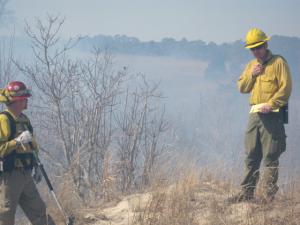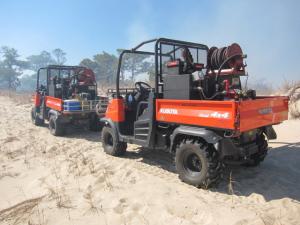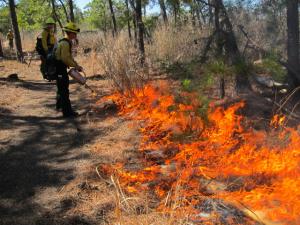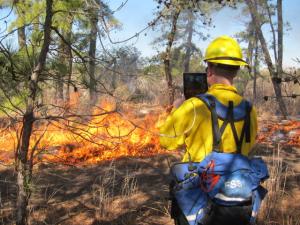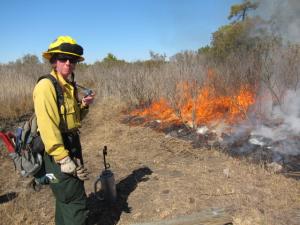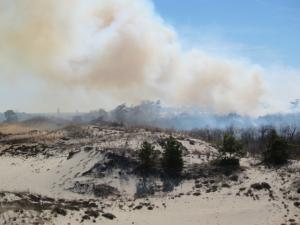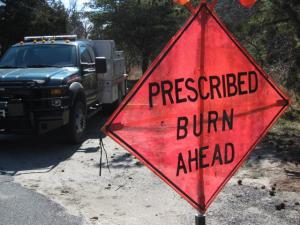Delaware environmental and forestry personnel completed a prescribed burn in a remote area of Cape Henlopen State Park on Tuesday this week. The exercise involving a total of 24 acres demonstrated how divisions can work together to accomplish specific goals they would be unlikely to accomplish otherwise.
The forestry personnel, trained in fighting fires as well as controlling them for a sanitizing effect, brought out specialized equipment for the task including two customized Kubota all-terrain vehicles with 70-gallon water tanks and foam fire-fighting equipment. Those vehicles are designed to allow personnel to get into very remote areas such as the thickets at the northern edge of Gordons Pond where this week’s prescribed burn took place.
The burn was designed to take out dry and dangerous tinder that could cause larger wildfires. However, special care was taken to preserve larger pines, red maples and other trees. Personnel cleared large circles around specific trees of special interest to prevent fast-moving fires from creating fatal damage.
While the exercise will help remove potential fire problems and open up the area beneath the trees so a variety of native and noninvasive plant species have a better chance to thrive, the prescribed burn also gave personnel a chance to use their skills at setting up fire breaks and precisely controlling the movement of fire when it is being used as a tool.
Here is the press release issued Tuesday afternoon by the public relations staff of the Department of Natural Resources and Environmental Control when the second day of the burn was under way:
LEWES (Feb. 28, 2012) – For the second day, DNREC’s Division of Parks and Recreation and the Delaware Department of Agriculture’s Forest Service are teaming up to conduct a prescribed fire on 24.2 acres in a remote area of Cape Henlopen State Park. The burn began yesterday, but had to be put on hold when humidity levels dropped too low. About 12 acres of the southernmost unit is being burned today, completing the prescribed burn.
“This will be the end of it today,” said Rob Line, Environmental Stewardship program manager with DNREC’s Division of Parks and Recreation. “Most of what’s left is phragmites - about 75 percent - and the rest is pine.”
A prescribed fire, unlike a wildfire, is an intentionally ignited fire set within limited and carefully defined weather conditions identified in a prescribed burn plan. Factors like fuel type, wind speed and direction, and air temperatures are critical factors considered in the plan.
Like yesterday, officials expect most of the smoke to travel out over the ocean, but Line said Rehoboth Beach residents might smell some smoke if winds shift to the south.
The main goal of the prescribed fire is to reduce the risk of forest wildfires by burning fine fuels such as pine needles, dead twigs and small dead branches, leaving larger woody debris unburned. Additional goals include reducing the overgrown shrub layer, to open the canopy to support state rare shade-intolerant herbs and grasses, and to consume dead phragmites canes that had been sprayed the previous fall, in order to enhance piping plover foraging habitat for young plovers.
The prescribed burn plan is designed to maximize safety and control, to effectively disperse smoke away from human populations and to accomplish the ecological objectives of the prescribed fire including habitat restoration. DNREC staff has been considering this measure for some time but the urgency of it was highlighted during site visits for planning the proposed Gordons Pond trail through the area. The burn will greatly improve habitat for vulnerable species in the vicinity of the new trail and help ensure public safety.
“This forest canopy needs to be opened up so that we can ensure the preservation of native species of rare plants, grasses and herbs along with the trees,” Line said. “This burn will start the restoration of these rare habitats.”
The prescribed burn is being coordinated by the Delaware Forest Service, which will provide key staff and conduct the burn. Today, 12 Forestry and Parks staff members are on site for the burn, along with four tankers of water.















